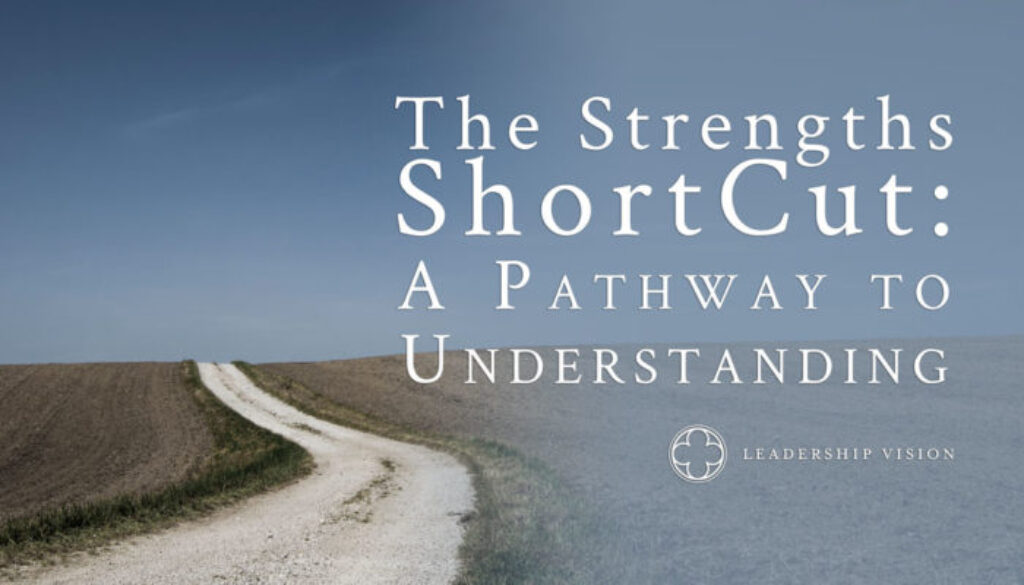The Strengths ShortCut: A Pathway to Understanding
“We do not see things as they are, we see them as we are.” Anais Nin
At Leadership Vision, we constantly seek to innovate our approach by connecting best practice in other domains to the integration of Strengths. This means we are forever learning, responding and creating ‘on demand’ services for clients that in turn become applicable in other contexts. While the nuances of each Team varies, most often the relational issues are similar. Recently, we were working with a Team that was ‘stuck’ in the ruts of routine and familiarity.
It was the perfect opportunity to create an experience for Teams that would layer Strengths with behavioral science. Social Psychologists like Heidi Grant Halvorson, have been studying human behavior as it relates to perspective, perception and social cognition. The term cognitive miser suggests that humans, valuing their mental processing resources, find different ways to save time and effort when negotiating the social world. We revert time and again, to the thinking pathway we know the best. In other words, we take mental short cuts. Not because we’re cheaters or lazy thinkers, but because with so many decisions to make, things to think, situations to understand and people to encounter… we can’t possibly take the mental scenic route every single time.
But think for a second what this means.
If we constantly put ourselves on autopilot and rarely take the long way around, or try a new route to our destination, what are we missing? What are we not seeing in the blur? The answer of course, is the details.
We become so accustomed to our own path, we assume that everyone else travels this way too. We assume that what we see along the way, others also see. In fact, we rarely even take time to notice the scenery around our well-worn tracks, because we assume there has been no change. And we wonder why anyone would ever go a different way, or take another road, or go through that area. It just doesn’t make sense. And unfortunately, we never even bother to ask them what they see along their way. Time and again, assumption and bias obstruct our view.
According to Halvorson,
the uncomfortable truth is that most of us don’t come across the way we intend. We can’t see ourselves truly objectively, and neither can anyone else. Human beings have a strong tendency to distort other people’s feedback to fit their own views.
And so, it is in the interpretation, that cavernous void that exists between intention and perception, where we find discord.
A Team Session
When using Strengths with Teams, it is necessary to create opportunities for individuals to eliminate this distortion. A Strengths experience that can begin to excavate personal assumptions and biases will allow people to recognize their own Strengths ShortCuts. By my definition, a Strengths ShortCut is our quick ‘go to’ for understanding ourselves, others and situations. A Strengths ShortCut is a cognitive attitude that presumes others relate, execute, think and influence the same way as you do. By understanding our own Strengths ShortCuts, we can create an awareness of how our assumptions and biases lead to misinterpretation and misunderstanding.
Just recently, with one professional team, I posed the following questions in sequence:
- What Strength(s) do you use to form relationships?
- What does this Strengths Shortcut look like for you?
- I assume that others……[complete the prompt]
- How could others misinterpret that assumption?
- What would you say or do to correct this?
The conversations were rich, meaningful and deeply contextualized. Colleagues were allowed the space to feedback, affirm and clarify.
Below is an excerpt of the reveal by one team member:
What Strengths do you use to form relationships?
“ I use Deliberative and Intellection. I think carefully and intensely.”
What does this Strengths Shortcut look like for you?
“Well… I enjoy getting to know people outside of our usual work context. I do this by asking provocative questions around religion, politics, current events and cultural practices. I like to engage in deep thinking myself and seek people out who will banter with me. “
I assume that others……
“I guess I assume that others like this kind of intense conversation too and don’t mind when I challenge their opinions. I assume people want intellectual agitation.”
How could others misinterpret that assumption?
“I’m often seen as the one stirring the pot or dissenting from the group because I can argue any side of an issue and will often do so just to keep myself intellectually stimulated. But I guess I’ve always been kind of polarizing that way. I wonder if people could also think that I don’t pay attention to certain people on the team just because I don’t think they’re smart enough.”
What would you say or do to correct this?
“Well. First, I’d say that I respect everybody and their opinion. Oftentimes when I’m arguing for a side, or asking to debate a provocative issue it’s just for the sake of great conversation. I just crave that. I don’t like you any less if you disagree with me or even if you have nothing to say at all. I should definitely be more mindful of who I am excluding from the conversation because I am not playing favorites and would never want you to think that.”
This is just one example of how the language of Strengths, with attention to our Strengths Shortcuts, can create a shared platform for perception. Interpretation is prodigious and fraught with error. But in allowing people to explore their own assumptions and translate their own intentions, we create a deeper sense of collective understanding within any Team. There are, after-all, many ways to get to the same destination.




